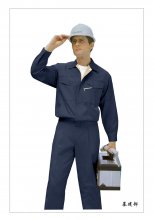As the saying goes, a person with 360 lines of work will be number one. As society develops, different types of work are distributed. If calculated, it is far more than 360 lines of work. So different industries require different professional work clothes. These Why do we need to wear work clothes when working in different industries? What are the differences and connections between work clothes and the ordinary fashion clothes we wear? What role do work clothes play when working?

1. Cooks and food workers should wear white overalls with buttons on the back, and the overalls should be longer than the knees, with fastened cuffs, and wear hats and masks to enhance cleanliness and prevent food contamination.
2. In addition to choosing work clothes according to the nature of the work, you should also pay attention to the exclusive use of work clothes. Work clothes should only be worn in the workplace and should not be taken home to prevent the spread of germs or poisons. You should also pay attention to keeping it clean and tidy, washing and mending it frequently to ensure that the work clothes play their due protective role.
3. When workers or laboratory personnel engaged in chemical production work in workshops or laboratories containing corrosive substances, in addition to wearing thicker tight-sleeved anti-corrosion overalls, they should also wear rubber aprons, long rubber gloves, and long rubber overshoes. . If necessary, you should also wear rubber overalls with a helmet that can be isolated from the outside world.
4. Agricultural production workers need to wear work clothes made of black coarse cloth or khaki cloth when performing general outdoor operations. Forest workers must wear three-tight overalls, with collars, cuffs, and ankles tightened to prevent pest infestations.
5. Mechanical workers often go between machines and need to prevent their clothes from being entangled by the machines and also need to be resistant to friction. Therefore, work clothes need to be tight-fitting, with hems, cuffs, and trouser legs that can be buttoned up. Moreover, the fabric needs to be strong and wear-resistant, and the color should be darker.
6. Reasonable clothing and work clothes can help regulate body temperature and protect the skin to achieve the purposes of waterproofing, fire protection, heat radiation protection, poison protection, and animal bite protection. Whether the clothing and work clothes are reasonable or not is directly related to human health.
7. When working in a high-temperature environment, the amount of contact heat radiation is large. Therefore, the work clothes worn when working in high-temperature conditions should be white or light-colored, and the fabric should be thick and soft. In addition, people sweat a lot when working under high temperatures, and some people like to go shirtless. This will cause thermal radiation to burn the skin, make the skin hot and dry, and reduce the heat dissipation function. It is also easy to cause physical injuries. Therefore, when working at high temperatures, you should not only wear clothes, but also wear thicker long-sleeved clothes and trousers, as well as gloves, masks, and foot guards.
There are still relatively strict regulations on the use of work clothes. For example, in hospitals and other places with very high cleanliness requirements, they must undergo strict sterilization and disinfection after wearing them. At the same time, in order to avoid cross-infection, etc., clothes from different departments are not allowed to be changed. Wear it. Do not wear it home after work. After wearing work clothes, you must wash them in time to remove dust, harmful particles and other impurities on the surface of the work clothes in time to avoid harm to your life and health.
Tag: work clothes





